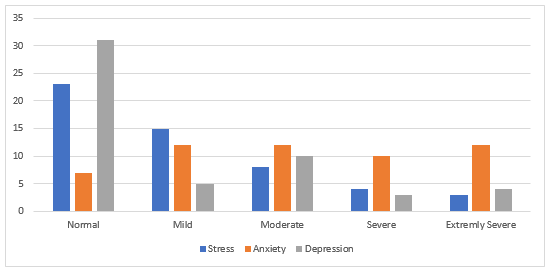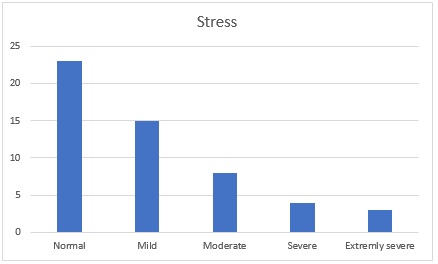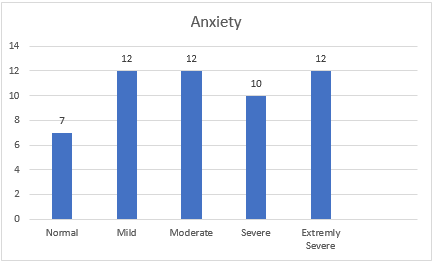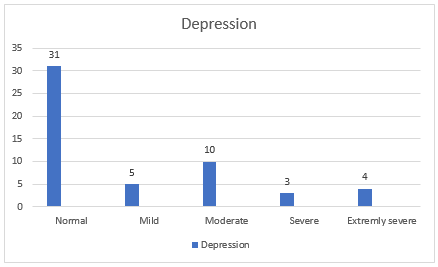Introduction
Clinical placement is acknowledged as a fundamental aspect of learning and professional development for students undertaking education in healthcare disciplines, as it enables students to integrate theoretical knowledge with clinical practice to develop skills and competencies (Graj, Sheen, & Dudley, 2019). Studies from different countries show that some clinical programmes have consistently demonstrated that health care students have higher stress and anxiety levels than the general population (Riberio & Pereira, 2018).1, 2, 3, 4, 5
Few studies have been completed on student midwives’ mental health in Australia. Similar studies looking at midwifery student burnout outside Australia have also highlighted the lack of research exploring student midwife secondary traumatic stress and burnout (Beaumont & Durkin, 2016). Student midwives are involved in the same undertakings as registered midwives; however, they do not have access to the many workplace-initiated mental health supports made available to registered midwives by their employers or unions. It is widely known that there needs to be ongoing mental health recognition, development and support for registered midwives, as multiple studies have shown they experience elevated levels of anxiety and depression due to the nature of their job (Kuipers & Mestdagh, 2023).
Stress is the body’s reaction to a trigger and is usually a short-term experience, whereas anxiety is a sustained mental health disorder that can be triggered by stress and can adversely affect social, occupational and other areas of functioning (Bennett, 2017). While some degree of stress acts as a stimulus for learning, excessive stress can disrupt the cognitive processes involved in memory and learning, negatively affecting academic outcomes (Dalton & Davidson, 2011). Depression is characterised by reduced self-esteem, apathy and anhedonia (Garcia & Martins, 2022). If students are exposed to high levels of anxiety, stress and depression, this can impact the quality of care they provide as well as their future in midwifery.
Australia is experiencing an increased need for student midwives due to a dire nurse/midwife shortage (Kuipers & Mestdagh, 2023). Poor psychological well-being can impact students’ completion of their studies, further exacerbating the problems of recruitment and retention in the midwifery workforce (Wynter & Redley, 2021). To maximise student retention, it is imperative that their experiences while undertaking the bachelor of midwifery are positive, and unnecessary challenges minimised, specifically mental health challenges (Fenwick & Gamble, 2016). Midwives are experts in their level of care, but often the road to becoming a midwife is not easy. They may encounter various outcomes, including both straightforward and complex pregnancies, which can have a profound impact on their emotional and mental well-being (Leinweber & Rowe, 2010). Midwives can indirectly experience traumatic events by witnessing them or listening to accounts of birthing episodes that encompass trauma exposure (Sheen & Spiby, 2015). Student midwives are also part of these discussions and also indirectly experience these traumatic events.
In 2017 a cross-sectional study found 20% of registered midwives in Australia reported moderate/severe/extreme levels of depression, anxiety and stress, having a medium-size effect on burnout (Creedy, Sidebotham, & Gamble, 2017). A study completed in the United Kingdom in 2017 for registered midwives found elevated levels of work-related burnout, stress, anxiety and depression (Hunter, Fenwick, & Sidebotham, 2019). Experiencing traumatic events as a midwife has been known to lead to feelings of shame, blame, isolation, helplessness and despair, which often makes them the second victim (McDaniel & Morris, 2020). The act of caring for people who have experienced trauma can sometimes lead to extreme consequences for the caregiver, including post-traumatic stress disorder, secondary traumatic stress and compassion fatigue (Leinweber & Rowe, 2010). A study completed on American midwives in 2018 examined stress and its sources and found that 97.1% experienced traumatic birth events, leading to increased depression and burnout (Wright, 2018), again confirming the traumatic exposure that midwives and student midwives are often privy to.6, 7, 8, 9
These stress disorders are often linked with depression, stress and anxiety, particularly the idea of burnout. Burnout is due to emotional exhaustion and low sense of personal accomplishment, often affected by occupational and sociodemographic variables (Altiparmak & Yilmaz, 2021). Due to these factors, burnout and depression are often linked, depending on the level of burnout the individual experiences (Altiparmak & Yilmaz, 2021). As well as dealing with the events of the job, other studies have also suggested that students can be adversely affected by having to manage individual behaviours and personalities of the registered midwives in the practicing environments (Baird & Gamble, 2022).
Stressful situations can have long-term impacts on midwives’ professional and personal identities (Halperin & Goldblatt, 2011). However, people often forget that student midwives can experience the same burnout as registered midwives, as they experience the same situations as their primary midwives. They may also have a minimal understanding of what took place, leaving many questions to remain unanswered after self-debriefs.
If student midwives are better equipped, with more and earlier mental health support, it is possible this number may decrease. A 2017 study of student midwives in the United Kingdom found that mindfulness interventions, work-based resilience workshops, and partnered mentoring programmes, created positive outcomes for student midwives (Pezaro & Fulton, 2017). Proper support and debriefing after adverse events can help students articulate their needs and develop resilience (Davies, 2015).10, 11, 12
Aim
The aim of this study was to address and provide evidence-based research on the mental health of student midwives. Psychological stress, anxiety and depression have been shown to have significant impacts on health care providers, impacting the quality of care they provide to women and the ability of midwives remaining in the profession (Cates & Mackenzie, 2024). With the increased need for registered midwives, it is important that the psychological well-being of students be prioritised, as it can impact the completion of student midwives’ studies, leading to implications in retention of students.
This research was intended to facilitate implementation of needed supports for student midwives on clinical placement and to encourage further research to be undertaken for student midwife mental health. Specifically, such mental health support would occur within university and hospital frameworks, where the students are currently on clinical placement. This study will hopefully flag the important role organisations have to play in improving environments for student midwives and preventing poor mental well-being from occurring (Kinman & Teoh, 2020).
Materials and Methods
Methodology
This study used a quantitative survey research method. The Depression Anxiety Stress Scales (DASS) questionnaire was utilised to assess the presence of generalised anxiety, depression and stress specifically associated with student midwives in Queensland. The DASS was developed by the Psychology Foundation of Australia (Lovibond & Lovibond, 1995). The DASS is a widely recognised and validated set of self-report scales designed to assess negative emotional states, specifically depression, anxiety and stress levels (Lovibond & Lovibond, 1995). The DASS questions were modified to reflect depression, anxiety and stress from a clinical setting. To determine the severity of symptoms related to anxiety, stress and depression, scores were determined using the DASS ranking of normal, mild, moderate, severe and extremely severe.
The questionnaire was completed anonymously and collected no individually identifiable information. However, sex and age were asked of respondents to determine whether these variables affected scores.
Inclusion criteria
Inclusion criteria were those who were currently student midwives on clinical placement over the age of 18 in Queensland. This included all first-, second- and third-year midwifery students, as long as they were undertaking clinical placement. Both male and female students were included in the study.
Data collection
The DASS scoring system assessed the frequency and severity of symptoms experienced by clinical student midwives regarding generalised anxiety and depression in the clinical setting. To gauge the severity of symptoms, the median score was used from their level of severity, e.g., never, sometimes, often, and almost always. The DASS questions were changed slightly to mirror symptoms while on clinical placement. The questionnaire was collected for 14 days via Survey Monkey. This online data collection method is confidential and ensures participant data is collected with enhanced security, including encryption. Private online social forums from universities in Queensland, who provide the Bachelor of Midwifery were used to advertise the survey to gain data from participants.
Results
Participant characteristics
The survey was completed by 53 individuals, all of whom were women. The age distribution of participants was as follows: 45.2% were between 18 and 20 years old, 30.19% were between 21 and 30 years old, 20.75% were between 31 and 40 years old, and 3.77% were between 41 and 50 years old.
Survey results
The following results were gathered, and the DASS score was calculated for each participant. Level of severity was based on each individual’s score, and the individual was placed into a category depending on their score. The severity categories were normal, mild, moderate, severe and extremely severe. The severity labels are used to describe the full range of scores in the population; therefore, ‘mild’ is interpreted as above the population mean, but probably still below the severity of someone seeking help (Lovibond & Lovibond, 1995).
Figure 1
Do student midwifes have elevated levels of anxiety, Depression and Stress. DASS score results. Y axis determines number of participants

Figure 2
Number of clinical student midwives presenting with varying severity categories of stress, y axis determines number of participants.

Figure 3
Number of clinical student midwives presenting with varying severity categories of anxiety, y axis determines number of participants.

Figure 4
Number of clinical student midwives presenting with varying severity categories of depression, y axis determines number of participants.

The data collected provides valuable insights into various areas, including stress, anxiety, and depression while on clinical placement for midwifery students. 53 participants participated in the survey and their scores were individually tallied, and based on their score, they were placed into the appropriate range as per the DASS criteria.
Stress
The analysis revealed that the majority of participants (23) experienced normal levels of stress. The number of participants decreased as the severity level increased, with 15 participants experiencing mild stress, 8 experiencing moderate stress, 4 experiencing severe stress, and only 3 experiencing extremely severe stress. This distribution suggests that while most participants do not experience significant stress, a notable portion still suffers from varying levels of increased stress.13, 14, 15, 16, 17, 18, 19, 20
Anxiety
Anxiety levels among participants were more evenly distributed compared to stress. Only 7 participants reported normal anxiety levels, while mild and moderate anxiety levels were reported by 12 participants each. Severe and extremely severe anxiety levels were observed in 10 and 12 participants, respectively. This even distribution indicates that anxiety is a prevalent issue among the participants, with a substantial number experiencing higher levels of anxiety.
Depression
The data for depression showed a pattern similar to that of stress, with the majority of participants (31) falling into the normal category. Fewer participants reported mild (5), moderate (10), severe (3), and extremely severe (4) levels of depression. This distribution suggests that while most participants do not experience significant depression, there is still a notable minority experiencing higher levels of depressive symptoms.
Discussion
Respondents reported frequent or constant symptoms of stress, including difficulty winding down, overreacting to situations, and anxiety symptoms such as trembling, breathing difficulties and nervous energy. More than 56% of respondents displayed elevated levels of stress while on clinical placement, and above 28% showed moderate to extremely severe levels of stress. These symptoms were felt whilst on clinical placement. More than 86% showed elevated levels of anxiety while on placement, with symptoms ranging between mild and extreme, while more than 64% showed moderate to extremely severe levels of anxiety while on clinical placement. A 2019 study of nursing and midwifery students’ stress during their undergraduate programmes found that stress emanated from both clinical and academic sources, but mainly from the clinical environment (McCarthy & Trace, 2018). These results mirror the findings the results. When assessing levels of anxiety, it may also be important to take into consideration what else may be taking place in the student’s life, such as social influences. While this particular study is based on students’ symptoms while on placement, outside influences should also be taken into consideration.
Several respondents report feelings of low mood, lack of enthusiasm, and low self-worth, although these are less prevalent than stress symptoms. 41.5% showed elevated levels of depression while on clinical placement with more than 32% showing moderate to extremely severe levels of depression. A larger study completed in 2016 looked at depressive symptoms in 417 nursing and midwifery students in Ireland. Their findings indicated that 34% of participants experienced depressive symptoms (Horgan & Sweeney, 2016). Although the level of depression was not specified in the 2016 study, similar symptoms to those experienced by the Queensland student midwives were also evident in the study. A similar study which also used the DASS score to determine levels of depression in Australian midwives found 20% reported severe levels of depression, compared to this study, which found 13% (Creedy, Sidebotham, & Gamble, 2017). These levels correspond more closely to the results of the present study.
Although the participant number for this study is small, it reflects a sampling of the current mental health struggles experienced by clinical student midwives while on placement. The findings are not generalisable but rather provide insight into the challenges of some student midwives.
Supporting the emotional well-being of student midwives is crucial not only for ensuring the provision of quality care to childbearing women but also for maintaining a healthy and motivated future workforce. By addressing the anxiety and depression experienced by student midwives, we can help create a supportive environment that promotes their overall well-being and future job satisfaction. This, in turn, can lead to improved retention rates and enhance the quality of care provided to women during childbirth.
Limitations
One possible limitation of this study is the relatively small number of participants, which may affect the robustness and generalisability of the results. With a limited sample size, the findings might not accurately represent the broader population of midwifery students. Conducting the study with a larger cohort would likely yield more reliable and significant results, providing a more comprehensive understanding of the issues at hand. A larger sample would also increase the statistical power of the study, allowing for more nuanced analysis and conclusions.
Additionally, the results might be skewed due to a self-selection bias. Individuals experiencing more severe mental health issues at the time of the research might have been more motivated to complete the survey. This could potentially lead to an overestimation of the prevalence and severity of mental health problems within the cohort. Therefore, it is important to consider this potential bias when interpreting the results, as it may affect the overall accuracy and reliability of the study’s conclusions. Future research should aim to address these limitations by employing strategies to mitigate self-selection bias and ensuring a larger, more representative sample. While there are many clinical sources of stress, the relationship between university staff and students, including the learning environment, can also lead to stress (Rezaei & Falahati, 2020).
Conclusion
Based on the findings presented, midwifery students experience a notable burden of stress and anxiety during their training. A considerable proportion reported frequent or constant symptoms such as difficulty winding down, overreacting to situations, trembling, breathing difficulties and nervous energy. Elevated levels of depression were evident, showing a relationship between clinical practice and depression-related symptoms that warrants further investigation.
In light of these findings, it is imperative that educational institutions and healthcare organizations prioritise the mental well-being of midwifery students. Implementing proactive measures, such as mental health support services, stress-management programmes, and opportunities for peer support and mentorship, can help mitigate the negative impact of stress, anxiety, and depression on student midwives. Additionally, fostering a culture of open communication and destigmatising discussions around mental health can encourage students to seek help when needed and promote a supportive learning environment.
By addressing the mental health needs of midwifery students, we can ensure they are adequately equipped to provide compassionate and effective care to expectant mothers and their families. Moreover, investing in the well-being of future midwives not only benefits the students themselves but also contributes to the overall resilience and sustainability of the midwifery profession.
Midwifery health care service requires very careful and continuous work, and the quality of care that midwives provide depends on their job satisfaction (Altiparmak & Yilmaz, 2021). If mental health is not prioritised early in student midwives’ careers, the anxiety or depression they experience may be detrimental to their future experience as a registered midwife providing health care services.
